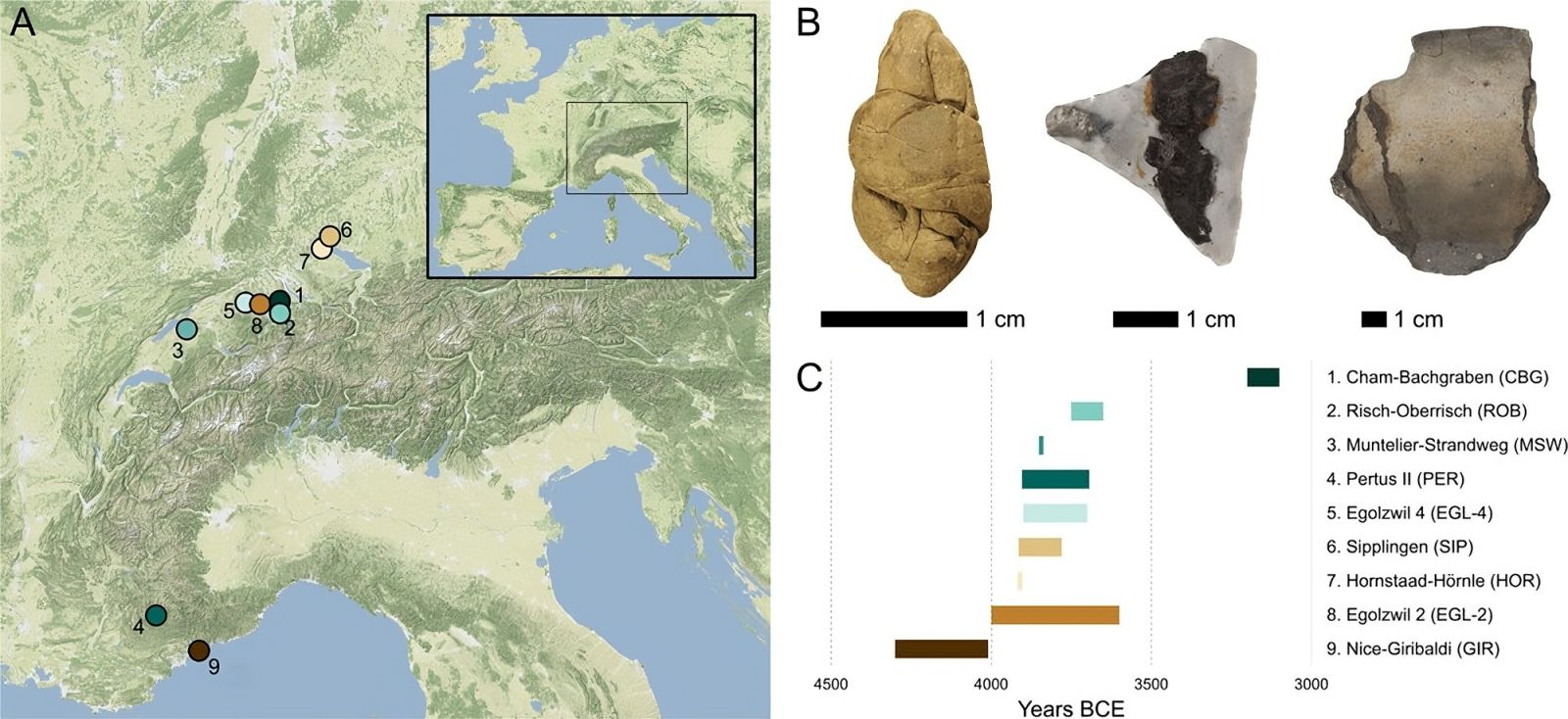🦷 What the discovery of these 6000-year-old chewing gums reveals
Published by Cédric,
Article author: Cédric DEPOND
Source: Proceedings of the Royal Society B
Other Languages: FR, DE, ES, PT
Article author: Cédric DEPOND
Source: Proceedings of the Royal Society B
Other Languages: FR, DE, ES, PT
Follow us on Google News (click on ☆)
The thorough analysis of these artifacts, particularly dental imprints and saliva trapped in the material, now reveals valuable information about the distribution of tasks between men and women during the Neolithic period. An international research team examined 30 archaeological samples, several of which showed characteristic bite marks, from nine different sites in the alpine region. Their cross-disciplinary methodology combines chemical analysis and ancient DNA sequencing to reconstruct the daily practices of these populations.

a) Map locating the nine archaeological sites from which the analyzed artifacts originate.
b) Types of artifacts studied: chewed pieces of birch tar, used for hafting or for repairing ceramic or wooden containers.
c) Approximate occupation periods (in years BC) of the studied sites.
Photos: Theis Z.T. Jensen.
The molecular memory of birch bark tar
The exceptional preservation of biological materials in birch bark tar allows for the identification of the origins of the people who used this substance. Researchers detected human DNA in 19 samples, with sufficient quality to determine the sex of individuals in several cases. This remarkable preservation is explained by the material's natural waterproof and antibacterial properties.
The study of organic residues trapped in the material provides insights into the diet and environment of these communities. Scientists identified traces of barley, wheat, peas, and hazelnuts, testifying to the agricultural practices of that time. The presence of poppy DNA raises questions about its food or medicinal use.
Visible dental marks on twelve of the samples confirm the mastication of this substance. The motivations for this practice may have included its medicinal virtues, maintaining oral hygiene, or the need to soften the material before use. The discovery of specific oral microbes supports this hypothesis.
A gendered distribution of activities
The examination of artifacts showed a differentiated distribution by sex in the use of birch tar. Samples found on stone tools, used to attach wooden handles, exclusively bore male markers. This observation shows a specialization of men in the field of manufacturing and using cutting tools.
Conversely, traces of birch tar used to repair pottery consistently showed female genetic signatures. This distribution likely indicates an assignment of container repair and maintenance tasks to women. The distinction appears clearly in the analysis of different types of objects.
The presence of both female and male DNA in the chewed pieces indicates that this practice was not reserved for one sex only. However, the purpose of using the material after mastication appears to have followed a structured social organization. This discovery offers a unique glimpse into the division of labor in these ancient societies.
To go further: What is birch bark tar?
Birch bark tar represents the first synthetic substance created by humans. Its production requires transforming birch bark through heating in the absence of oxygen. This complex technical process appears as early as the Middle Paleolithic.
This material has remarkable adhesive and waterproof properties. Neolithic communities used it as glue for hafting tools, waterproofing containers, and repairing pottery. Its chemical composition gives it great stability over time.
The substance naturally contains compounds with antiseptic effects. Some hypotheses suggest its use to relieve dental pain or as a mouth disinfectant. Its mastication could also serve to soften the material before application.